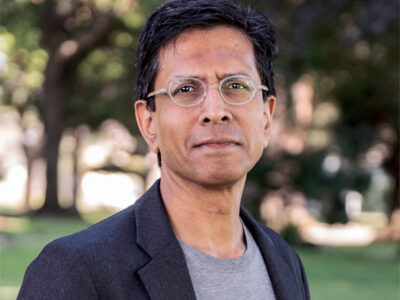
Dr. Eduardo D. Glandt GCh’75 Gr’77, the new dean of the School of Engineering and Applied Science, is a familiar face, being an alumnus, a distinguished member of the faculty and, most recently, the school’s interim dean. But in the rapidly-evolving field that his school represents, the chemical-engineering professor brings a certain dynamic fluidity to the post, as well as the ability to interface with multiple disciplines.
“Chemical engineers are very arrogant in thinking that chemical engineering is the crossroads of technology,” he says with a laugh. “We’re close to material science, to mechanical engineering, to systems engineering and to bioengineering. So I am, I think, as conversant with the various fields as anyone.”
The Argentine-born Glandt, who joined Penn’s faculty as an assistant professor in 1975, became interim dean when Dr. Gregory S. Farrington resigned in August 1998 to become president of Lehigh University. Glandt’s interim leadership was hailed by President Judith Rodin as an “exemplary period” of attracting new resources, supporting interdisciplinary teaching and research, and making significant faculty appointments. When he was named permanent dean in early November, Rodin called the search committee’s choice “a tribute to the great strength of our faculty,” and described Glandt as the “best possible person to lead the school into the next century.”
Glandt, who served as chairman of the chemical-engineering department from 1991-1994 and held the Russell P. and Elizabeth C. Heuer Professorship from 1995-1998, says that his “overarching goal is to bring this school to prominence.” SEAS has “extraordinary talents all around it,” he adds, and its strengths are the “students and the faculty,” as well as its links to Penn’s other schools. In the short term, he intends to “focus on letting the world know what’s going on here,” and to “put tremendous reinvigoration into our doctoral programs, which are already strong.”
Among the most pressing immediate needs is for more and better space. “The school is behind on its physical plant,” he acknowledges. “We want to attract some distinguished scholars, and we know that the main barrier to that is that we don’t have, in their present form, the appropriate space to offer them. So we are about to break ground on new facilities.” In addition to the new building—the Melvin J. Levine Center for Computer Information and Cognitive Sciences, scheduled to open in November 2001—Glandt notes that the Towne building and the Graduate Research Wing of the Moore School building will be undergoing “major renovations.”
The school is “poised for outreach to the region, where there is a great pharmaceutical industry and now a biotech industry,” he says. “We are building initiatives in biotechnology, computer information science and advanced materials.” A major advantage is SEAS’ connections with Penn’s other schools, especially the School of Medicine and Wharton: “We’ve done a number of joint programs with them already, but we want to build on that.”
Along with information technology—which “affects every discipline, every aspect of our lives”—Glandt notes that the other technological development that will profoundly affect engineering is the “arrival of the biological sciences as almost exact sciences.” While it may be a “trite metaphor,” he says, the notion that “biology will be to the technology of the 21st century what physics was to the technology of the 20th century” is “unmistakably true.” As a result, “We have to bring the biological and medical sciences into existing courses. This is the moment where textbooks are being rewritten, or are about to be rewritten. And hopefully the Penn faculty will do the rewriting.”
It’s in a good position to do so, he points out. Two of the three top engineering positions in the National Science Foundation (NSF)—which is “in charge of setting the direction for engineering research and education in the United States”—are from Penn. One is Dr. Joseph Bordogna EE’55 GrE’64, the Alfred Fitler Moore Professor and emeritus dean of SEAS, now the NSF’s deputy director; the other is Dr. Ruzena Bajcsy, professor of computer and information science [“The Vision Thing,” July/Aug 1999], currently director of the NSF’s division of Computer and Information Science and Engineering.
Glandt himself earned his bachelor’s degree from the University of Buenos Aires in 1968, and served for six years at Argentina’s National Institute of Industrial Technology. In 1969 he came to the United States as a visiting researcher for the Bureau of Mines and as a United Nations Fellow. He received his master’s degree from Penn in 1975, followed by his Ph.D. two years later. His research has focused on classical and statistical thermodynamics, theories of liquids and of liquid mixtures, adsorption, interfacial phenomena, membrane partitioning, colloids and heterogeneous media.
A member of the National Academy of Engineering himself since 1996, Glandt notes that just about every year another member of the school’s faculty is elected to that prestigious institution, and he describes the younger members of the faculty as having “star quality.”
“Things have gotten so good,” he adds wryly, “that we the old-timers might not be able to get in.”




